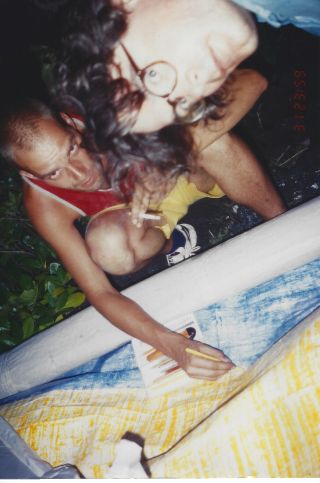Philosophy
Time and Existence: How Artists Try to Grasp the Ineffable
How the time concepts of Chronos and Kairos are represented in contemporary art.
Updated August 6, 2023 Reviewed by Jessica Schrader
Key points
- The Greek word chronos covers the aspect of time that refers to duration and the expiration of human time.
- The Greek word kairos denotes the "right moment," the importance of now.
- Kathy Paterson’s art project Future Library covers the chronos aspect of time.
While we were walking to Martin Heidegger’s hut in the Black Forrest, fellow time researcher and psychologist Julia Mossbridge reminded me of the artist Kathy Paterson’s art project Future Library. Having planted 1,000 trees near the Norwegian capital of Oslo in the year 2014, these trees will be cut in 2114 to be used as paper for 100 chapters of an anthology of books that from 2014 onwards, year by year, is being written by selected writers and stored away until the year of the book production. Some of the future writers are not yet born, and in 2114 Kathy Paterson will be dead. The 100 years are of a magnitude that is just beyond the potential life span of (even young) adults who witnessed the start of the project. In 2114, some humans will have been born before 2014 and only a handful of people on the planet might have heard about the project in 2014. For the artist, this project is a way of measuring her lifetime and grasping mortality. Quite a fitting topic on our way to the hut of Martin Heidegger, the philosopher who wrote about time and existence: we should face our finitude and mortality and through this realization lead a more authentic and meaningful life, he demanded.
Kathy Paterson’s art is about grasping life’s duration. The Greek word chronos covers this aspect of time, the chronology and—for us humans—the expiration of time. Another aspect of time is covered by the Greek word kairos, which denotes the "right moment," the importance of now. This aspect of time is experienced painfully, when we missed the one opportunity that will not repeat itself. Events unfold across time and the moment is irrevocably gone. One could argue from an existential point of view that the two aspects of time go hand in hand. Only the awareness of the finitude of life enables us to savor the moment. Each moment is special, as it vanishes the next moment. In an earlier Psychology Today post, I have written about the question concerning "how long is now?"
Seize the day: the Japanese artist On Kawara in his Today Series painted the date of each day on canvas. In his series postcards, Kawara wrote postcards to friends around the world, stamping them with the exact date, indicating the exact address where he wrote them and the time when he got up from bed. Every day thus becomes special as part of the art project which was the life of On Kawara. Previously, I have written in a Psychology Today post about an idea stemming from biology: that our self is more a process than a thing. Our nature of being is transitory and not stable. To grow old and die is what we have to face. Biology meets Heidegger. We can learn to accept our nature, our life (chronos) passing moment by moment (kairos). This learning is epitomized by artist Roman Opalka, who from 1965 to his death in 2011 painted numbers on canvas, having started with one and (his) ending with 5,607,249.

A personal report at the end of this post. In mid-1999, my friend Dirk Thiel and I decided to become the last two persons of the 20th century. We had read that people were flying to New Zeeland or even Tonga to be among the first to welcome the coming millennium. In a fit of euphoria in a Munich bar, we said that we wanted to be the last people of the 20th century. This fitted our personal impression of being the last in so many aspects of life ... Looking at maps and the globe, we found the Pacific Islands of Samoa to be closest to the date line and the last spot on land where one can celebrate New Year’s Eve. We read about people, who with their boats traversed the date line to enjoy two New Year’s Eves. But we were on land. The most western tip of the island of Savaii.

Our idea was to become our turn of the millennium. In addition, as an artist, Dirk painted the last picture of the millennium on the beaches of Samoa during the last days of 1999 where we spent the nights in fales, simple beach huts. On Dec. 31, we went to the most Western tip of the island of Savaii, cape Mulinuu, where one second before midnight Dirk signed the last art work of the 2nd millennium.
Our life and its finitude are real. The measurement of time with clocks and calendars is to some extent a convention. Dirk Thiel, my friend from our school days and the artist of the last painting of the 2nd millennium, died last year. In 2011, Samoa changed its time frame and shifted from the western to the eastern side of the international date line. Now, Samoans can celebrate the New Year as the first people on the globe.
In memory of Dirk Thiel (1967–2022).


